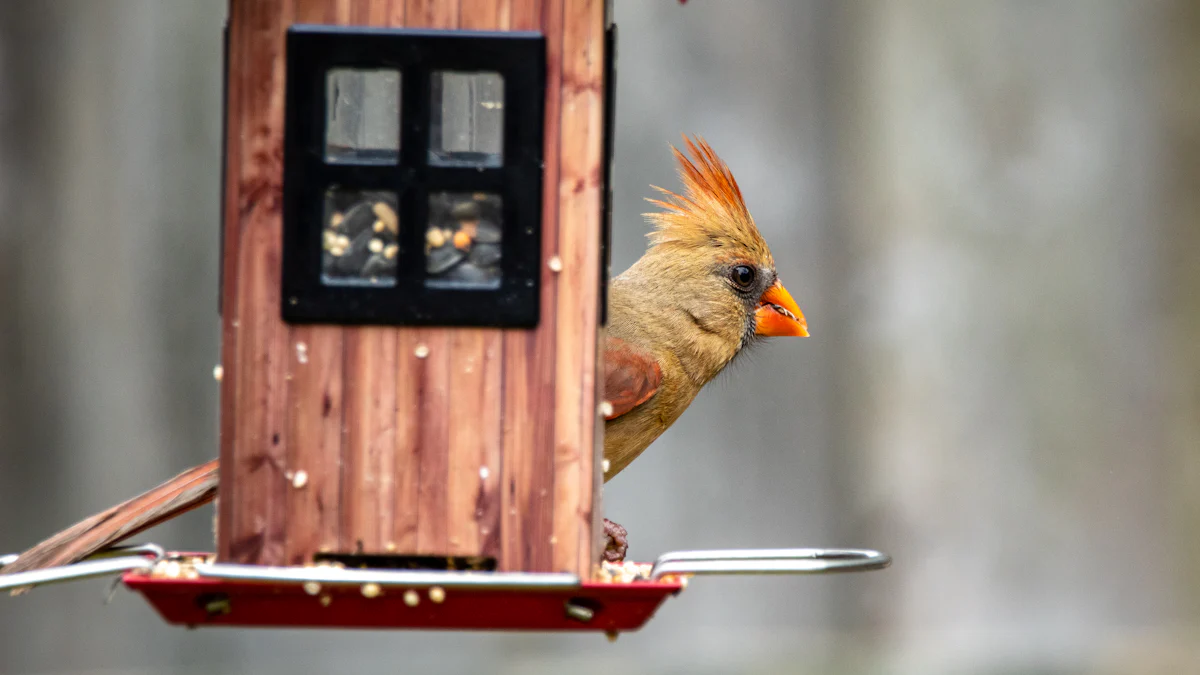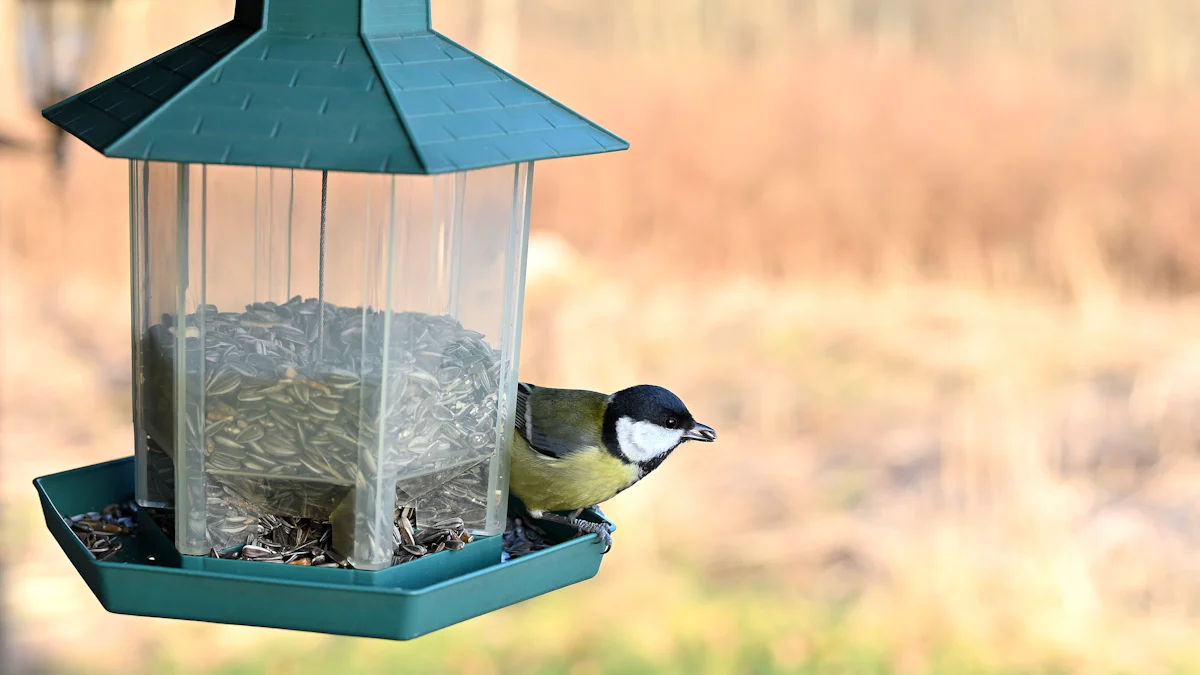
Understanding what birds eat is crucial for anyone who loves watching these feathered friends. Birds have diverse diets that change with the seasons. Some birds munch on insects, while others prefer seeds or fruits. You can help by providing food like birdseed and feedbirds, especially during tough times like winter. Feeders become lifelines when natural resources dwindle. Your efforts can support bird survival and even influence their life cycles. So, let's dive into what makes up a bird's menu and how you can lend a hand.
Understanding Bird Diets
Natural Diets of Birds
Insectivorous Birds

Insectivorous birds feast on insects. These birds include warblers and woodpeckers. They hunt for beetles, caterpillars, and ants. Insects provide essential proteins. These proteins help with growth and energy. Insectivorous birds often visit gardens. You can attract them by avoiding pesticides. Native plants also draw insects. This creates a natural buffet for these birds.
Granivorous Birds
Granivorous birds love seeds. Sparrows and finches belong to this group. Seeds offer carbohydrates and fats. These nutrients fuel their daily activities. Granivorous birds enjoy sunflower seeds. Studies show a preference for sunflower seeds in both rural and urban areas. You can support these birds by offering mixed seeds. A variety of seeds attracts different species.
Frugivorous Birds

Frugivorous birds munch on fruits. Robins and orioles are examples. Fruits provide vitamins and sugars. These nutrients boost their health. Frugivorous birds prefer berries and apples. You can plant fruit-bearing trees to attract them. Fresh fruits in feeders also work well. This helps during times when natural fruits are scarce.
Nectarivorous Birds

Nectarivorous birds sip nectar. Hummingbirds and sunbirds fall into this category. Nectar offers quick energy. Sugars in nectar fuel their rapid movements. Nectarivorous birds visit flowers with tubular shapes. You can plant flowers like trumpet vine. Sugar-water feeders also attract them. Avoid using red dye in the water. Red dye can harm these delicate creatures.
Seasonal Variations in Diet
Winter Feeding Habits
Winter changes bird diets. Food becomes scarce. Birds rely on seeds and suet. Sunflower seeds remain a favorite. Suet provides fats for warmth. Bird-feeders become crucial in winter. Research shows that feeders influence bird populations. Urban areas see a rise in bird numbers due to feeding. You can help by keeping feeders full. This support aids bird survival in harsh weather.
Summer Feeding Habits
Summer brings abundance. Birds find insects and fruits easily. Insectivorous birds thrive on bugs. Frugivorous birds enjoy ripe fruits. You can reduce feeder offerings in summer. Natural food sources meet their needs. Focus on providing fresh water instead. Water helps birds stay hydrated in the heat. A birdbath or shallow dish works well. Clean water attracts a variety of species.
Feedbirds: Providing Food to Birds

Feeding birds in your backyard can be a rewarding experience. You get to watch a variety of birds up close. Providing food also helps birds survive during challenging times. Let's explore how you can set up feeders and choose the right feed for your feathered visitors.
Types of Feeders
Platform Feeders
Platform feeders, or tray feeders, offer a simple design. A flat seed tray sits within a frame. This open design attracts many bird species. Birds of various sizes can feed at once. Some birds perch on the feeder walls. Others hop right into the seed. Platform feeders create a lively feeding scene. You can use any type of seed with these feeders.
Tube Feeders
Tube feeders are popular for their squirrel-proof features. These feeders have clear plastic tubes. Caps, bases, and perches are made of plastic or metal. Some tube feeders have weight-sensitive technology. This feature closes seed ports when a heavy weight is detected. Squirrels can't access the seeds, but birds can. Tube feeders often hang from poles. This setup keeps squirrels away. Tube feeders attract finches, sparrows, and other small birds.
Suet Feeders
Suet feeders provide high-energy food. Birds need this energy, especially in winter. Suet comes in blocks or cakes. These feeders often have wire cages. Birds cling to the cage while feeding. Woodpeckers, nuthatches, and chickadees love suet. You can hang suet feeders from trees or poles. Suet feeders add variety to your bird-feeding station.
Choosing the Right Feed for Feedbirds
Seeds and Grains
Seeds and grains form the backbone of bird diets. Sunflower seeds are a favorite among many species. Black-oil sunflower seeds offer high nutritional value. Millet and safflower seeds also attract birds. You can mix different seeds to draw diverse species. Avoid salted or processed seeds. These can harm bird health.
Fruits and Nuts
Fruits and nuts appeal to frugivorous birds. Robins and bluebirds enjoy fruits like raisins and currants. You can offer chopped apples or berries. Nuts like peanuts provide protein and fats. Make sure nuts are unsalted. Fresh fruits and nuts add variety to bird diets.
Suet and Fat
Suet and fat provide essential energy. Birds need this energy in cold weather. You can buy suet cakes or make your own. Mix suet with seeds or dried fruits. Hang suet feeders in shaded areas. This prevents melting in warm weather. Suet attracts insectivorous birds and woodpeckers.
Feeding birds can transform your backyard into a bustling bird haven. Choose the right feeders and feed to support local bird populations. Your efforts make a difference, especially during tough seasons.
Birdseed: A Popular Choice for Feedbirds

Birdseed plays a vital role in attracting and nourishing birds in your backyard. Different types of birdseed cater to various bird species. Understanding these can help you make informed choices.
Common Types of Birdseed
Sunflower Seeds
Sunflower seeds rank as a top choice for many bird species. Birds like cardinals and chickadees love them. The seeds offer high nutritional value. Black-oil sunflower seeds have thin shells. Birds find these easy to crack open. You can fill feeders with sunflower seeds to attract a wide range of birds.
Millet
Millet appeals to ground-feeding birds. Sparrows and doves enjoy millet. This small seed provides essential nutrients. Millet works well in platform feeders. You can scatter millet on the ground to draw more birds. Offering millet can increase bird visits to your yard.
Safflower
Safflower seeds attract birds like cardinals and grosbeaks. These seeds have a bitter taste. Squirrels often avoid safflower seeds. The seeds contain protein and fat. Birds benefit from these nutrients. You can use safflower seeds to deter squirrels while feeding birds.
Benefits of Using Birdseed
Nutritional Value
Birdseed provides essential nutrients. Seeds offer proteins, fats, and carbohydrates. These nutrients support bird health and energy. Sunflower seeds stand out for their high oil content. Millet and safflower also contribute valuable nutrition. Providing birdseed helps birds thrive.
Attracting Different Bird Species
Birdseed attracts a variety of bird species. Different seeds appeal to different birds. Sunflower seeds draw cardinals and finches. Millet brings in sparrows and doves. Safflower seeds attract grosbeaks and cardinals. Offering a mix of seeds can diversify your bird visitors. Birdseed creates a lively and active backyard environment.
Understanding bird diets plays a vital role in supporting bird populations. Providing appropriate food helps birds thrive, especially during challenging seasons. Your efforts can make a significant impact on local wildlife. Bird feeding offers a chance to connect with nature and contribute to ecological balance. A well-planned feeding strategy attracts diverse species and supports their nutritional needs. By offering a variety of foods, you create a safe haven for birds. Your backyard becomes a sanctuary that aids bird survival and enhances biodiversity. Keep feeders stocked and enjoy the lively presence of feathered visitors.
Take your birding experience to the next level with a smart bird feeder equipped with a camera - track your avian guests, monitor their activity, and gain valuable insights to optimize your feeding efforts. Be the neighborhood's bird haven and make a lasting difference in your local ecosystem.













